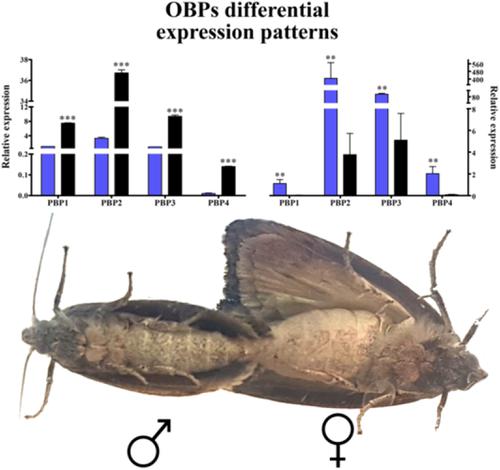当前位置:
X-MOL 学术
›
Insect Mol. Biol.
›
论文详情
Our official English website, www.x-mol.net, welcomes your
feedback! (Note: you will need to create a separate account there.)
Mating-based regulation and ligand binding of an odorant-binding protein support the inverse sexual communication of the greater wax moth, Galleria mellonella (Lepidoptera: Pyralidae).
Insect Molecular Biology ( IF 2.3 ) Pub Date : 2020-03-01 , DOI: 10.1111/imb.12638 P Lizana 1, 2 , J Machuca 2 , G Larama 3 , A Quiroz 2, 4 , A Mutis 2, 4 , H Venthur 2, 4
Insect Molecular Biology ( IF 2.3 ) Pub Date : 2020-03-01 , DOI: 10.1111/imb.12638 P Lizana 1, 2 , J Machuca 2 , G Larama 3 , A Quiroz 2, 4 , A Mutis 2, 4 , H Venthur 2, 4
Affiliation

|
In moths, sex pheromones play a key role in mate finding. These chemicals are transported in the antennae by odorant‐binding proteins (OBPs). Commonly, males encounter conspecific females; therefore, several OBPs are male‐biased. Less is known, however, about how the olfactory system of moths has evolved toward inverse sexual communication, ie where females seek males. Therefore, the objective of this study was to identify the profile of OBPs and their expression patterns in the bee hive pest, Galleria mellonella, a moth that uses inverse sexual communication. Here, OBP‐related transcripts were identified by an RNA Sequencing (RNA‐Seq) approach and analysed through both Reverse Transcription Polymerase Chain Reaction (RT‐PCR) in different tissues and quantitative real‐time PCR for two states, virgin and postmating. Our results indicate that G. mellonella has 20 OBPs distributed amongst different tissues. Interestingly, 17 of the 20 OBPs were significantly down‐regulated after mating in females, whereas only OBP7 was up‐regulated. By contrast, 18 OBP transcripts were up‐regulated in males after mating. Additionally, binding assays and structural simulations showed general odorant‐binding protein 2 (GOBP2) was able to bind sex pheromone components and analogues. These findings suggest a possible role of OBPs, especially GOBPs, in the inverse sexual communication of G. mellonella, with gene expression regulated as a response to mating.
中文翻译:

基于交配的调节和气味结合蛋白的配体结合支持更大的蜡蛾马勒菌(鳞翅目:Pyralidae)的逆性沟通。
在飞蛾中,性信息素在寻找伴侣中起关键作用。这些化学物质通过气味结合蛋白(OBP)在触角中传输。通常,男性会遇到特定的女性。因此,几个OBP是男性偏见的。然而,关于飞蛾的嗅觉系统是如何发展成反向性交的,即雌性寻找雄性的信息,人们所知甚少。因此,本研究的目的是鉴定在蜂巢害虫,Galleria mellonella(一种使用反向性交性的飞蛾)中的OBP概况及其表达模式。在这里,OBP通过RNA测序(RNA-Seq)方法鉴定相关的转录本,并通过逆转录聚合酶链反应(RT-PCR)在不同组织中进行定量分析,并通过实时定量PCR对两种状态进行分析,即原始状态和后配对状态。我们的研究结果表明,大蜡螟有20个OBPs分布不同的组织之间。有趣的是,雌性交配后的20个OBP中有17个被显着下调,而只有OBP7被上调。相比之下,18 OBP交配后,雄性的转录本上调。此外,结合测定和结构模拟表明,一般的气味结合蛋白2(GOBP2)能够结合性信息素成分和类似物。这些发现表明OBPs,尤其GOBPs的可能的作用,在逆性通信蜡螟,具有调节以配合一个响应基因的表达。
更新日期:2020-03-01
中文翻译:

基于交配的调节和气味结合蛋白的配体结合支持更大的蜡蛾马勒菌(鳞翅目:Pyralidae)的逆性沟通。
在飞蛾中,性信息素在寻找伴侣中起关键作用。这些化学物质通过气味结合蛋白(OBP)在触角中传输。通常,男性会遇到特定的女性。因此,几个OBP是男性偏见的。然而,关于飞蛾的嗅觉系统是如何发展成反向性交的,即雌性寻找雄性的信息,人们所知甚少。因此,本研究的目的是鉴定在蜂巢害虫,Galleria mellonella(一种使用反向性交性的飞蛾)中的OBP概况及其表达模式。在这里,OBP通过RNA测序(RNA-Seq)方法鉴定相关的转录本,并通过逆转录聚合酶链反应(RT-PCR)在不同组织中进行定量分析,并通过实时定量PCR对两种状态进行分析,即原始状态和后配对状态。我们的研究结果表明,大蜡螟有20个OBPs分布不同的组织之间。有趣的是,雌性交配后的20个OBP中有17个被显着下调,而只有OBP7被上调。相比之下,18 OBP交配后,雄性的转录本上调。此外,结合测定和结构模拟表明,一般的气味结合蛋白2(GOBP2)能够结合性信息素成分和类似物。这些发现表明OBPs,尤其GOBPs的可能的作用,在逆性通信蜡螟,具有调节以配合一个响应基因的表达。











































 京公网安备 11010802027423号
京公网安备 11010802027423号